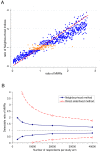The neighbourhood method for measuring differences in maternal mortality, infant mortality and other rare demographic events
- PMID: 24392088
- PMCID: PMC3879230
- DOI: 10.1371/journal.pone.0083590
The neighbourhood method for measuring differences in maternal mortality, infant mortality and other rare demographic events
Abstract
In the absence of reliable systems for registering rare types of vital events large surveys are required to measure changes in their rates. However some events such as maternal deaths are widely known about in the community. This study examined the utility of asking respondents about events in their neighbourhood as an efficient method for measuring relative rates of rare health events such as maternal and infant deaths. A survey was conducted in the health and demographic surveillance system (HDSS) in Matlab, Bangladesh, which includes two areas with different health care regimes. Adult women were asked about any maternal deaths; multiple births; infant deaths, live births and some other events they knew of in a small specified area around their home. Agreement between HDSS records and survey responses was moderate or better (kappa≥0.44) for all the events and greatest for maternal deaths (kappa = 0.77) with 84% being reported. Most events were more likely to be reported if they were recent (p<0.05). Infant mortality rate in one area was 0.56 times that in the other which was well reflected by the ratio of survey results (0.53). Simulations were used to study the ability of the method to detect differences in maternal mortality ratio. These suggested that a sample size around 5000 would give 80% power to detect a 50% decrease from a baseline of 183 which compared well with an estimated sample size around 10 times larger using the direct sisterhood method. The findings suggest that the Neighbourhood Method has potential for monitoring relative differences between areas or changes over time in the rates of rare demographic events, requiring considerably smaller sample sizes than traditional methods. This raises the possibility for interventions to demonstrate real effects on outcomes such as maternal deaths where previously this was only feasible by indirect methods.
Conflict of interest statement
Figures

References
-
- Graham WJ, Foster LB Davidson L, Hauke E, Campbell OMR (2008) Measuring progress in reducing maternal mortality. Best Pract Res Clin Obstet Gynaecol 22: 425–445. - PubMed
-
- Bryce J, Terreri N, Victoria CG, Mason E, Daelmans B, et al. (2006) Coutdown to 2015: tracking intervention coverage for child survival. Lancet 368: 1067–1076. - PubMed
-
- Hill K, Thomas K, AbouZahr C, Walker N, Say L, et al. (2007) Estimates of maternal mortality between 1990 and 2005: an assessment of available data. Lancet 370: 1311–1319. - PubMed
-
- Yazback AS (2007) Comment: challenges in measuring maternal mortality. Lancet 370: 1291–1292. - PubMed
Publication types
MeSH terms
LinkOut - more resources
Full Text Sources
Other Literature Sources

